语法-动词不定式与一般将来时
- 格式:docx
- 大小:32.67 KB
- 文档页数:12

英语中的十六种时态(1)一般现在时基本形式(以do为例):第三人称单数:does(主语为非第三人称单数);肯定句:主语+动词原形+其他;He works for us.否定句:主语+don't/doesn't+动词原形+其他;He doesn't work for us.一般疑问句:Do/Does+主语+动词原形+其他。
肯定回答:Yes,(+主语+do/does).否定回答:No,(+主语+don't/doesn't.)特殊疑问句:疑问词+一般疑问句语Does he work for us?Yes, he does.No, he doesn'tWhat does he do for us?He works for us.(2)一般过去时be动词+行为动词的过去式否定句式:在行为动词前加didn't,同时还原行为动词,或was/were+not;was或were放于句首;用助动词do的过去式did提问,同时还原行为动词例如: Did he work for us?He didn't work for us.He worked for us.(3)一般将来时am/are/is+going to+do 或will/shall+doam/is/are/about to + doam/is/are to + do;一般将来时的表达方法be going to +动词原形be +不定式,be to+动词原形,be about to +动词原形be able to +不定式be about to+动词原形will + 动词原形;例如:He is going to work for us.He will work for us;He is coming.这是特殊的用一般现在时表达将来时态的例子!!(4)过去将来时be(was,were)going to+动词原形be(was,were)about to+动词原形be(was,were)to+动词原形肯定句:主语+be(was,were)going to+动词原形~.否定句:主语+be(was,were)not going to+动词原形~.疑问句:Be(Was,Were)+主语+going to+动词原形~?肯定句:主语+would(should)+动词原形~.否定句:主语+would(should)not+动词原形~.疑问句:Would(Should)+主语+动词原形~?He would work for us.(5)现在进行时主语+be+v.ing〔现在分词〕形式(其中v表示动词)表示现在正在进行的动作或最近在做的事。
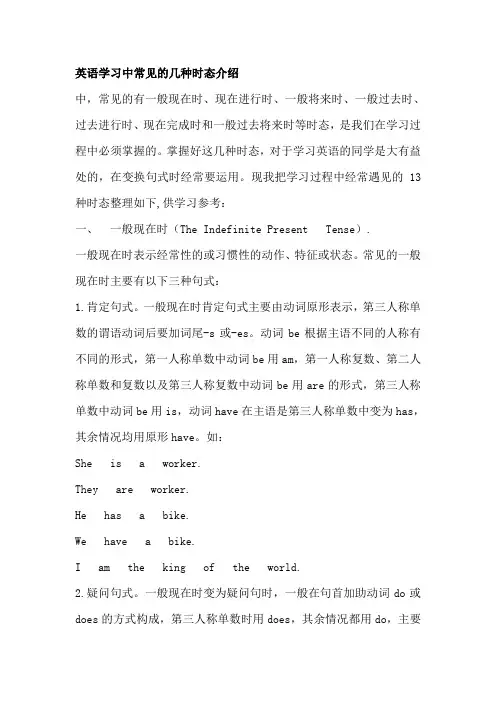
英语学习中常见的几种时态介绍中,常见的有一般现在时、现在进行时、一般将来时、一般过去时、过去进行时、现在完成时和一般过去将来时等时态,是我们在学习过程中必须掌握的。
掌握好这几种时态,对于学习英语的同学是大有益处的,在变换句式时经常要运用。
现我把学习过程中经常遇见的13种时态整理如下,供学习参考:一、一般现在时(The Indefinite Present Tense).一般现在时表示经常性的或习惯性的动作、特征或状态。
常见的一般现在时主要有以下三种句式:1.肯定句式。
一般现在时肯定句式主要由动词原形表示,第三人称单数的谓语动词后要加词尾-s或-es。
动词be根据主语不同的人称有不同的形式,第一人称单数中动词be用am,第一人称复数、第二人称单数和复数以及第三人称复数中动词be用are的形式,第三人称单数中动词be用is,动词have在主语是第三人称单数中变为has,其余情况均用原形have。
如:She is a worker.They are worker.He has a bike.We have a bike.I am the king of the world.2.疑问句式。
一般现在时变为疑问句时,一般在句首加助动词do或does的方式构成,第三人称单数时用does,其余情况都用do,主要动词一概不变,用原形;在以have或has为主要动词的句子中,可以直接将动词have或has提前放于句首,也可以在句首加动词do或does构成,have或has一律用原形have。
如:Do you work?Does he work?Has she a cake?Does she have a cake?其简略回答形式用“Yes+主语+动词”或“No+主语+动词+not”。
如:Yes, I do.No, he does not.Yes, she hasNo, she has not.3.否定句式。
一般现在时的否定句式在动词前加do/does not的形式构成。
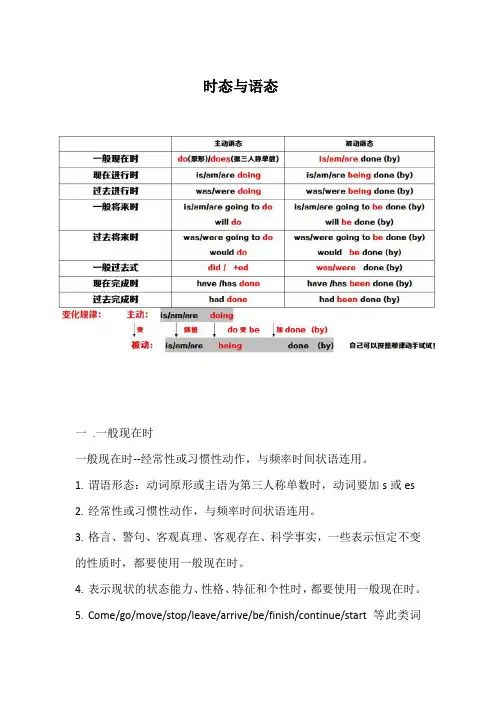
时态与语态一.一般现在时一般现在时--经常性或习惯性动作,与频率时间状语连用。
1.谓语形态:动词原形或主语为第三人称单数时,动词要加s或es2.经常性或习惯性动作,与频率时间状语连用。
3.格言、警句、客观真理、客观存在、科学事实,一些表示恒定不变的性质时,都要使用一般现在时。
4.表示现状的状态能力、性格、特征和个性时,都要使用一般现在时。
e/go/move/stop/leave/arrive/be/finish/continue/start等此类词本身表示计划,将要发生的动作等,常用一般现在时表示将来的状况6.在时间状语从句或条件状语从句中的重点考点-主将从现--用一般现在时代替一般将来时例句:1.The earth moves around the sun.2.The train comes at 3 o’clock.二.一般过去时一般过去式--表示在过去的时间内,动作已发生或完成。
谓语形态:动词要变为过去式。
一般是动词后+ed或不规则变化1.一般过去式表示在过去的时间内,动作已发生或完成。
2.标志词:通常,一般过去时带有表示动作发生的时间的词,词组或从句,如yesterday,the day before yesterday,last week,two days ago等,但上下文清楚时可以不带时间状语。
3.过去经常,反复发生的动作,也可用used to或would加动词原形来表达。
used to也可用于表示过去曾经存在过的状态。
I used to go fishing on Sundays.During the holiday he would go fishing.This river used to be clean.4.使用一般过去时的特殊句型如下:(1)It's time+(that)从句。
It's time we had supper.(2)sb.+wish+(that)从句。

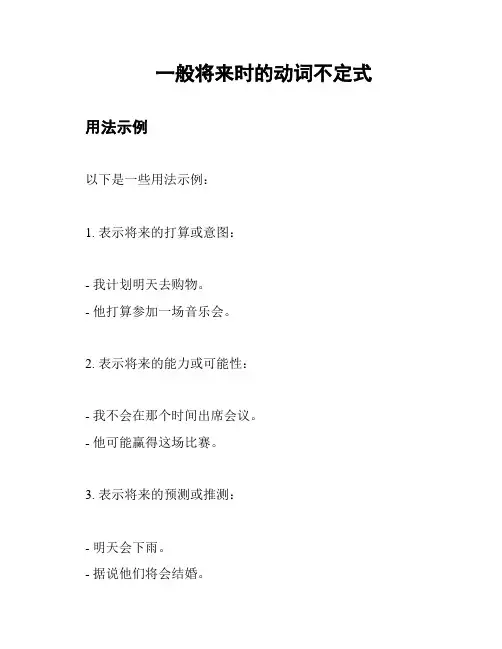
一般将来时的动词不定式用法示例
以下是一些用法示例:
1. 表示将来的打算或意图:
- 我计划明天去购物。
- 他打算参加一场音乐会。
2. 表示将来的能力或可能性:
- 我不会在那个时间出席会议。
- 他可能赢得这场比赛。
3. 表示将来的预测或推测:
- 明天会下雨。
- 据说他们将会结婚。
注意事项
1. 不定式常与情态动词连用,如 can, could, may, might, will, would 等。
2. 动词不定式一般不与表示将来时间的副词连用,因为不定式本身已经表示将来。
3. 不定式前可以加情态动词的否定形式,如 can't, couldn't, won't, wouldn't 等。
总结
一般将来时的动词不定式用于表示将来某个时间点或事件发生的动作或状态。
它可以表示打算、意图、能力、可能性、预测等。
在使用时要注意与情态动词的搭配以及不与表示将来时间的副词连用。
希望以上内容对你有所帮助。
> 注意:以上内容是根据一般将来时的用法和常见规则总结而来,具体应用时请根据实际语境和语法规则进行判断和运用。
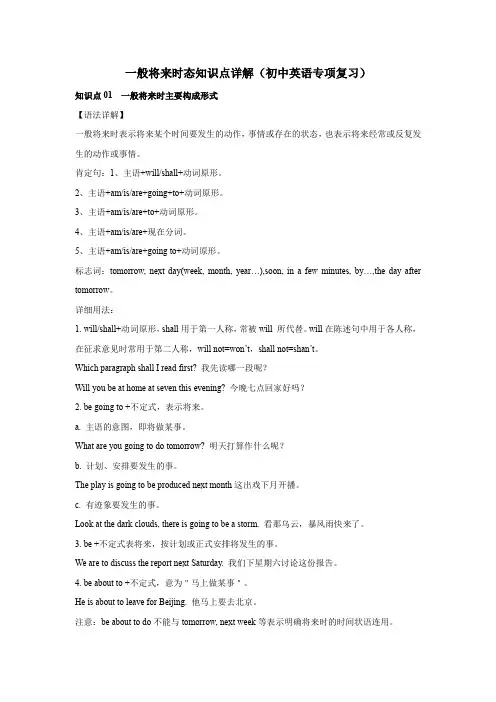
一般将来时态知识点详解(初中英语专项复习)知识点01 一般将来时主要构成形式【语法详解】一般将来时表示将来某个时间要发生的动作,事情或存在的状态,也表示将来经常或反复发生的动作或事情。
肯定句:1、主语+will/shall+动词原形。
2、主语+am/is/are+going+to+动词原形。
3、主语+am/is/are+to+动词原形。
4、主语+am/is/are+现在分词。
5、主语+am/is/are+going to+动词原形。
标志词:tomorrow, next day(week, month, year…),soon, in a few minutes, by…,the day after tomorrow。
详细用法:1. will/shall+动词原形,shall用于第一人称,常被will 所代替。
will在陈述句中用于各人称,在征求意见时常用于第二人称,will not=won’t,shall not=shan’t。
Which paragraph shall I read first? 我先读哪一段呢?Will you be at home at seven this evening? 今晚七点回家好吗?2. be going to +不定式,表示将来。
a. 主语的意图,即将做某事。
What are you going to do tomorrow? 明天打算作什么呢?b. 计划、安排要发生的事。
The play is going to be produced next month这出戏下月开播。
c. 有迹象要发生的事。
Look at the dark clouds, there is going to be a storm. 看那乌云,暴风雨快来了。
3. be +不定式表将来,按计划或正式安排将发生的事。
We are to discuss the report next Saturday. 我们下星期六讨论这份报告。
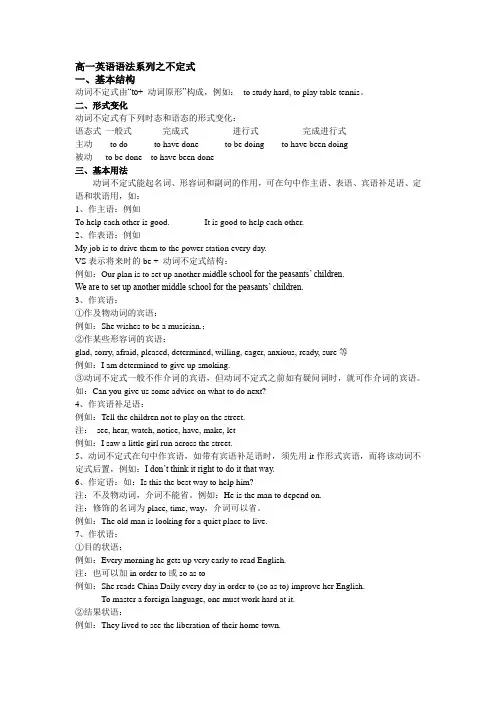
高一英语语法系列之不定式一、基本结构动词不定式由“to+ 动词原形”构成,例如:to study hard, to play table tennis。
二、形式变化动词不定式有下列时态和语态的形式变化:语态式一般式完成式进行式完成进行式主动to do to have done to be doing to have been doing被动to be done to have been done三、基本用法动词不定式能起名词、形容词和副词的作用,可在句中作主语、表语、宾语补足语、定语和状语用,如:1、作主语:例如To help each other is good. It is good to help each other.2、作表语:例如My job is to drive them to the power station every day.VS表示将来时的be + 动词不定式结构:例如:Our plan is to set up another mid dle school for the peasants’ children.We are to set up another middle school for the peasants’ children.3、作宾语:①作及物动词的宾语:例如:She wishes to be a musician.;②作某些形容词的宾语:glad, sorry, afraid, pleased, determined, willing, eager, anxious, ready, sure等例如:I am determined to give up smoking.③动词不定式一般不作介词的宾语,但动词不定式之前如有疑问词时,就可作介词的宾语。
如:Can you give us some advice on what to do next?4、作宾语补足语:例如:Tell the children not to play on the street.注:see, hear, watch, notice, have, make, let例如:I saw a little girl run across the street.5、动词不定式在句中作宾语,如带有宾语补足语时,须先用it作形式宾语,而将该动词不定式后置,例如:I don’t think it right to do it that way.6、作定语:如:Is this the best way to help him?注:不及物动词,介词不能省。

【英语语法手册】一般将来时的基本概念和形式将来一般时的基本概念和形式将来一般时(future indefinite tense)表示将来某一时刻的动作或状态,或将来某一段时间内经常的动作或状态。
将来一般时由助动词shall(第一人称)或will(第二、三人称)+动词原形构成。
美国英语则不管什么人称,一律用will现将将来一般时在肯定、否定、一般疑问及其简略答语等四种结构中。
将来一般时的用法1)表示将来的动作或状态,常与一些表示将来的时间状语连用,如:tomorrow(明天),next week(下周),from now on(从现在开始),in a month(一个月后),in the future(将来)等。
如:My daughter will be twelve years old tomorrow.我的女儿明天整十二岁。
He will come to see you the day after tomorrow.他后天要来看你。
The indoor swimming pool will be open to the public from October 16.室内游泳池自十月十六日起开放。
He will go to the technical training class every other day.他将每隔一天到技术训练班去学习。
I shall go back to see my childhood friends in the summer vacation.暑假我要回去看我儿时的朋友。
Today we shall have a report on the situation in Africa.我们今天有关于非洲形势的报告。
2)表示将来经常发生的动作。
如:We shall work in this factory everyday.我们将每天在这工厂工作。
其他表示将来的说法1)"be going + 动词不定式''多用于口语中,常表示打算、即将、决心去做的事或可能要发生的事。
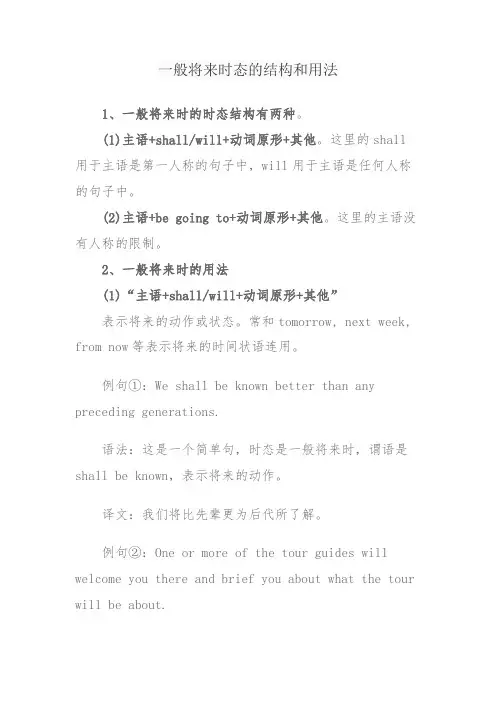
一般将来时态的结构和用法1、一般将来时的时态结构有两种。
(1)主语+shall/will+动词原形+其他。
这里的shall 用于主语是第一人称的句子中,will用于主语是任何人称的句子中。
(2)主语+be going to+动词原形+其他。
这里的主语没有人称的限制。
2、一般将来时的用法(1)“主语+shall/will+动词原形+其他”表示将来的动作或状态。
常和tomorrow, next week, from now等表示将来的时间状语连用。
例句①:We shall be known better than any preceding generations.语法:这是一个简单句,时态是一般将来时,谓语是shall be known,表示将来的动作。
译文:我们将比先辈更为后代所了解。
例句②:One or more of the tour guides will welcome you there and brief you about what the tour will be about.语法:这是一个主从复合句。
what引导的是宾语从句;主句和从句的时态都是一般将来时,谓语分别是will welcome…and brief和will be,表示将来的动作。
译文:有一个或几个导游会到那里迎接你们,并且向你们简要介绍参观的内容。
(2)“be going to+动词原形+其他”表示事先考虑过的将要发生的动作以及已有迹象表明必将要发生的某事,意为“打算,就要”。
例句:Now we go to Jane who is going to tell us about what's happening in town this weekend.语法:这是一个多重主从复合句。
who引导的是定语从句,该从句的时态是一般将来时,谓语是is going to tell;该定语从句中又包含一个由what引导的宾语从句,作介词about的宾语。
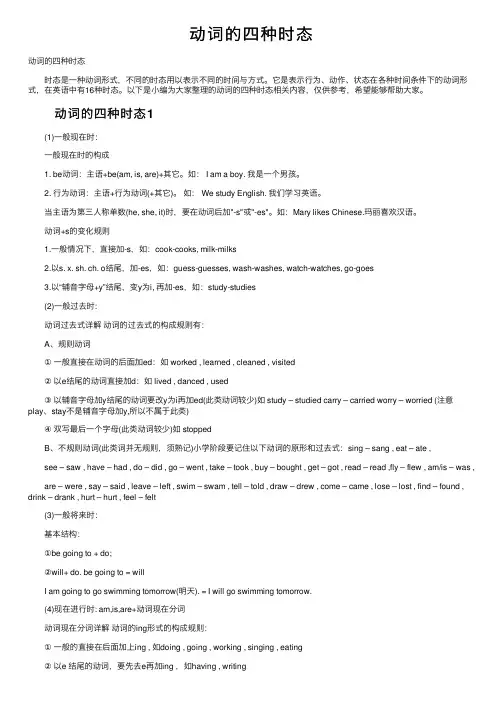
动词的四种时态动词的四种时态 时态是⼀种动词形式,不同的时态⽤以表⽰不同的时间与⽅式。
它是表⽰⾏为、动作、状态在各种时间条件下的动词形式,在英语中有16种时态。
以下是⼩编为⼤家整理的动词的四种时态相关内容,仅供参考,希望能够帮助⼤家。
动词的四种时态1 (1)⼀般现在时: ⼀般现在时的构成 1. be动词:主语+be(am, is, are)+其它。
如: I am a boy. 我是⼀个男孩。
2. ⾏为动词:主语+⾏为动词(+其它)。
如: We study English. 我们学习英语。
当主语为第三⼈称单数(he, she, it)时,要在动词后加"-s"或"-es"。
如:Mary likes Chinese.玛丽喜欢汉语。
动词+s的变化规则 1.⼀般情况下,直接加-s,如:cook-cooks, milk-milks 2.以s. x. sh. ch. o结尾,加-es,如:guess-guesses, wash-washes, watch-watches, go-goes 3.以“辅⾳字母+y”结尾,变y为i, 再加-es,如:study-studies (2)⼀般过去时: 动词过去式详解动词的过去式的构成规则有: A、规则动词 ①⼀般直接在动词的后⾯加ed:如 worked , learned , cleaned , visited ②以e结尾的动词直接加d:如 lived , danced , used ③以辅⾳字母加y结尾的动词要改y为i再加ed(此类动词较少)如 study – studied carry – carried worry – worried (注意play、stay不是辅⾳字母加y,所以不属于此类) ④双写最后⼀个字母(此类动词较少)如 stopped B、不规则动词(此类词并⽆规则,须熟记)⼩学阶段要记住以下动词的原形和过去式:sing – sang , eat – ate , see – saw , have – had , do – did , go – went , take – took , buy – bought , get – got , read – read ,fly – flew , am/is – was , are – were , say – said , leave – left , swim – swam , tell – told , draw – drew , come – came , lose – lost , find – found , drink – drank , hurt – hurt , feel – felt (3)⼀般将来时: 基本结构: ①be going to + do; ②will+ do. be going to = will I am going to go swimming tomorrow(明天). = I will go swimming tomorrow. (4)现在进⾏时: am,is,are+动词现在分词 动词现在分词详解动词的ing形式的构成规则: ①⼀般的直接在后⾯加上ing , 如doing , going , working , singing , eating ②以e 结尾的动词,要先去e再加ing ,如having , writing ③双写最后⼀个字母的(此类动词极少)有:running , swimming , sitting , getting 动词的四种时态2 ⼀般现在时 主要⽤来表⽰⼈、事物的现在状况和特点;表⽰经常或习惯性的动作,句⼦中常有often, always, from time to time 等时间状语;表⽰客观规律和永恒真理等。
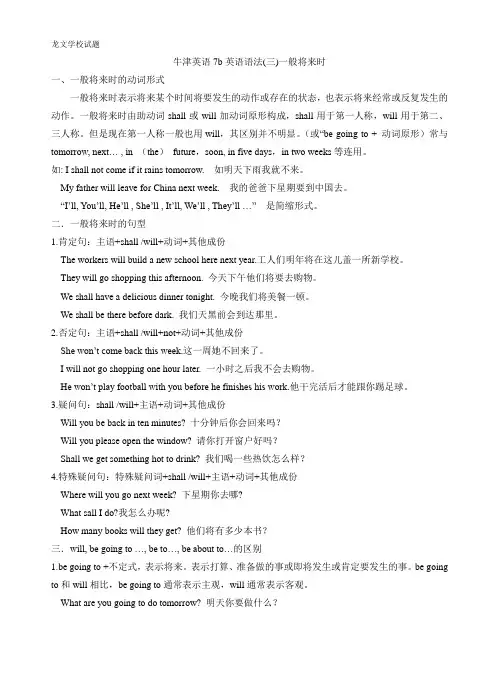
牛津英语7b英语语法(三)一般将来时一、一般将来时的动词形式一般将来时表示将来某个时间将要发生的动作或存在的状态,也表示将来经常或反复发生的动作。
一般将来时由助动词shall或will加动词原形构成,shall用于第一人称,will用于第二、三人称。
但是现在第一人称一般也用will,其区别并不明显。
(或“be going to + 动词原形)常与tomorrow, next… , in (the)future,soon, in five days,in two weeks等连用。
如: I shall not come if it rains tomorrow.如明天下雨我就不来。
My father will leave for China next week.我的爸爸下星期要到中国去。
“I’ll, You’ll, He’ll , She’ll , It’ll, We’ll , They’ll …”是简缩形式。
二.一般将来时的句型1.肯定句:主语+shall /will+动词+其他成份The workers will build a new school here next year.工人们明年将在这儿盖一所新学校。
They will go shopping this afternoon. 今天下午他们将要去购物。
We shall have a delicious dinner tonight. 今晚我们将美餐一顿。
We shall be there before dark. 我们天黑前会到达那里。
2.否定句:主语+shall /will+not+动词+其他成份She won’t come back this week.这一周她不回来了。
I will not go shopping one hour later. 一小时之后我不会去购物。
He won’t play football with you before he finishes his work.他干完活后才能跟你踢足球。
小学英语“一般将来时”语法知识一、概念表示将来某个时间要发生的动作或存在的状态,常与一些表示将来的时间状语连用。
例如:I am going to/will watch a football match on TV this evening.今天晚上我将在电视上看一场足球比赛。
二、一般将来时的形式❆will 常简略为'll,并与主语连写在一起,如:I'll,he'll,it'll,we'll,you'll,they'll。
❆一般疑问句如用Will you…?其简略答语须是Yes,I will或No,I will not;如用Shall you…?(较少见)其简略答语须是Yes,I shall.或No,I shall not.。
三、一般将来时的用法❆表示将来的动作或状态一般将来时常与一些表示将来的时间状语连用,如:tomorrow(明天),next week (下周),from now on(从现在开始);in the future(将来)等。
❆表示将来经常发生的动作。
一般将来时表示将来某一时刻的动作或状态,其表达形式除了“shall(第一人称),will(第二、三人称)+动词原形构成”外,还有以下几种形式。
1)“to be going to+动词原形”表示即将发生的或最近打算进行的事。
例如:①It is going to rain. 要下雨了。
②We are going to have a meeting today. 今天我们开会。
2)go,come,start,move,sail,leave,arrive,stay等可用进行时态表示按计划即将发生的动作,例如:I'm leaving for Beijing.我要去北京。
3)“be to+动词原形”表示按计划要发生的事或征求对方意见。
例如:①Are we to go on with this work?我们继续干吗?②The boy is to go to school tomorrow.这个男孩明天要去上学。
初中英语语法归纳:一般未来时【1 】英语语法一般未来时暗示未来某个时光要产生的动作,工作或消失的状况,也暗示未来经常或重复产生的动作或工作.那么,英语一般未来时的句子构造和语法特色是如何的呢?下面为您讲授一下.1)will/shall+动词本相 shall用于第一人称,常被will 所代替.will 在陈述句顶用于大家称,在收罗看法时经常应用于第二人称.will not=won't shall not=shan't例如:Which paragraph shall I read first? 我先读哪一段呢?Will you be at home at seven this evening? 今晚七点回家好吗?2) be going to +不定式,暗示未来.a. 主语的意图,即将做某事.例如:What are you going to do tomorrow? 明天打算作什么呢?b. 筹划,安插要产生的事.例如:The play is going to be produced next month.这出戏下月开播.c. 有迹象要产生的事.例如:Look at the dark clouds, there is going to be a storm. 看那乌云,将近下雨了.3) be +不定式表未来,按筹划或正式安插将产生的事.例如:We are to discuss the report next Saturday.我们下礼拜六评论辩论这份陈述.4) be about to +不定式,意为立时做某事.例如:He is about to leave for Beijing. 他立时要去北京.留意:be about to do 不克不及与tomorrow, next week 等暗示明白未来时的时光状语连用.Notice:be to和be going tobe to 暗示客不雅安插或受人指导而做某事,be going to 暗示主不雅的打算或筹划.例如:I am to play football tomorrow afternoon. 明世界午我去踢球.(客不雅安插)I'm going to play football tomorrow afternoon. 明世界午我想去踢球.(主不雅安插)5)如今进行时表未来时下列动词的如今进行时暗示未来时e.fly.leave.start.begin.finish.end.arrive and so on.she is leaving for Wuhan tomorrow.6)一般如今时表未来1)下列动词come, go, arrive, leave, start, begin, return的一般如今时可以暗示未来,重要用来暗示在时光上已肯定或安插好的工作.例如:The train leaves at six tomorrow morning. 火车明天上午六点开.When does the bus star? It stars in ten minutes. 汽车什么时刻开?十分钟后.2)以here, there等开端的倒装句,暗示动作正在进行.一般未来时罕有构造大比拼1. “be going to+动词本相”构造用来暗示按照主不雅意图打算或按筹划,安插将要做的事,有“打算.就要”的意思.也经常应用于暗示从迹象上标明将要产生的工作,多指小我主不雅臆断的推想.如:Look at the clouds. It’s going to rain. 看这些云,要下雨了.2. “shall或will+动词本相”指对未来事物近期或远期的预感,表达小我主不雅意图以及收罗对方看法或暗示虚心的邀请.在书面语中,shall多用于第一人称;在白话中,will可以用于任何人称.如:I shall/will show my photos to you next Monday. 我下周一给你看我的照片.句型转换1. “be going to+动词本相”构造的一般疑问句是将be的响应情势前移到句首,即“Are/Is/A m+主语+going to+动词本相+其它?”.其否认句是在be动词的响应情势后加not.如:(1)They are going to play football this afternoon.(肯定句)(2)Are they going to play football this afternoon?(一般疑问句)(3)They are not going to play football this afternoon. (否认句)2. “shall/will+动词本相”构造的一般疑问句是将shall或will前移到句首,即“Shall/Will+主语+动词本相+其它?”.其否认句是在shall或will后加not.如:(1)Our teacher will come back very soon. (肯定句)(2)Will our teacher come back very soon?(一般疑问句)(3)Our teacher won’t come back very soon. (否认句)一般未来时的用法一般未来时的用法(1)暗示将要产生的动作.Perhaps I shall (will) pay a visit to France this winter. 可能在本年冬天到法国不雅光.We shan't (won’t) be free tomorrow. 们明天没空.Will you be at home at seven this evening? 今晚七点你会在家吗?The agreement will come into force next spring. 协定将在来岁春生成效.经常应用于此类情形的时光状语有:tomorrow明天,next year来岁,from now on从如今起,in a month一个月之后,in the future未来,等.today今天,this evening今天晚上,this week这个礼拜,this month这个月,this year本年,等.一般未来时的用法(2)“be going to +不定式”多用于白话中,暗示打算.将要产生的事.What are you going to do tomorrow? 明天你要干什么?We are going to visit the Summer Palace next week. 下个礼拜我们要去不雅赏颐和园.Look at the dark clouds, there is going to be a storm. 看那乌云,暴风雨快来了.一般未来时的用法(3)“be +不定式”暗示安插或筹划好了的动作.When are they to hand in their plan? 他们的筹划什么时刻交上来?The queen is to visit Japan next year. 女王将于来岁访日.一般未来时的用法(4) “be about +不定式”暗示即将产生的动作.He is about to retire. 他即将退休. The English evening is about to begin. 英语晚会即将开端.留意:be about to 一般不与时光状语连用.一般未来时的用法(5)come,go等动词用“一般如今时”暗示按划定.筹划或时光表将要产生的事.He starts next week. 他下个礼拜动身.We leave very soon. 我们很快就分开.The train starts at 10 o'clock in the morning. 火车将在早上10点开出.这类用法限于暗示"移动"的动词:come来,go去,leave分开,start动身,begin开端,arrive到达,depart分开,stay勾留,等.一般未来时的用法(6)come,go等动词在白话顶用“如今进行时”暗示主语筹划将要作的动作.They are leaving for New York tomorrow. 明天他们将要动身前去纽约.Is your brother departing soon? 你的兄弟很快就要动身吗?这类情形常与come来,go去,leave分开,start开端,begin开端,arrive到达,depart分开,stay勾留,等动词连用.所用的动词必须是动作而不是状况,主语必须是人.come,go等动词的用法比较come,go等动词用“一般如今时”暗示按划定.筹划或时光表将要产生的事.(较为严厉,正式;主语可所以人,也可所以交通对象.会议.戏剧或片子.) come,go等动词在白话顶用“如今进行时”暗示主语筹划将要作的动作.(较为宽松,主语必须是人.)The train leaves the station at 11:20. 火车将在11点20分别站.We are leaving for Boston next week. 我们将鄙人周前去波士顿.What time does the film begin? 片子几点开映?Is your sister staying here long? 你的姐妹在这儿会勾留很长时光吗?He starts next week. 他下周动身.She is departing soon. 她很快就要动身.will和be going to的选用原则1. 关于“打算”本来作好的打算用“be going to”.“Kate is in hospital.” “Yes, I know. I am going to see her this afternoon.”“凯特在住院.”“是的,我知道.我下昼要去看她.”措辞时即时的打算用“will”.“Kate is in hospital.” “Oh, really, I didn’t know. I will go and see her at once.”“凯特在住院.”“哦,是吗?我都不知道呢.我得立时去看她.”2. 关于“预感” 在有迹象标明的情形下的预感用“be going to”Look at the clouds. It’s going to rain. 你看天上的云.快下雨了.My God! We are going to crash. 天哪!我们快撞车了.在没有迹象标明的情形下进行的猜测用“will,be going to”皆可.I think the weather will be nice.I think the weather is going to be nice. 我想天会晴朗.Do you think the car will start?Do you think the car is going to start? 你想车能动员起来吗?当动词暗示心坎运动时,暗示猜测的句子必须用“will”I think she will like the cake I made for her. 我想她会爱好我为她做的蛋糕.常和一般未来时连用的时光状语暗示将要产生的动作.Perhaps I shall (will) pay a visit to France this winter. 我可能在本年冬天到法国不雅光.We shan't (won’t) be free tomorrow. 我们明天没空.Will you be at home at seven this evening? 今晚七点你会在家吗?The agreement will come into force next spring. 协定将在来岁春生成效.经常应用于此类情形的时光状语有:tomorrow明天,next year来岁,from now on从如今起,in a month一个月之后,in the future未来,等.today今天,this evening今天晚上,this week这个礼拜,this month这个月,this year本年,等.。
英语语法篇之动词不定式动词不定式用法灵活多样;尽管有些动词或短语后面既可以接to do 又可以接doing ,但只要用心观察,发现还是可以找到规律的。
与其说是动词不定式,到还不如说是动词“定式”。
因为我们可以大体上把它分为三类形式,即: do / to do / doing动词不定式没有人称和数的变化,在句中不能独立作谓语,是非谓语形式的一种。
但动词不定式具有名词、形容词和副词特征,在句中可以作主语、宾语、宾语补足语、定语、表语和状语等多种成分。
另外,动词不定式具有动词特点,可以有自己的宾语和状语,组成动词不定式短语。
动词不定式的基本(肯定)形式是to+do,有时可以不带to;其否定形式是not to+do。
1.作主语可以直接作主语。
如:To see is to believe.但在英语中,常用it作形式主语,真正的主语即动词不定式放在后面。
如:It's wrong to play tricks on other people.It's our duty to keep our environment clean and tidy.规律:动词不定式在句中作主语时,常放在It is +adj.(形容词)+to do sth.或It is +n.(名词)+to do sth.句型中,it仅作形式主语。
2.作宾语常可接动词不定式作宾语的动词有:agree(同意), hope(希望), decide(决定), need(需要), mean(打算), wish(希望), fail(失败), want(想要), begin(开始), would like(想要等。
Ask(请求), beg(乞求), leave, like, love, hate(讨厌), prefer(宁愿), order(命令), teach, (教)tell,(告诉)believe(相信), find,(找出)know,(知道)want,(想要)think,(认为)understand,(明白)a.want,decide ,agree等动词后面跟并且只能跟不定式。
如:We agreed to start early. She wants to be a doctor.b.love,like ,begin,start,hate ,prefer等词后面可以接不定式。
规律:上述动词后面除接不定式外,还可以接动名词,意思无很大区别。
贴士:like doing指经常性动作,而like to do指一次性的动作。
如:I like swimming,but I don't like to swim now.我喜欢游泳,但我现在不想游。
c.stop,forget,remember,go on ,try等词或短语后面可以接不定式。
规律:上述动词后面接不定式和接动名词意思大不相同。
贴士:1)stop to do sth.:停止一件事,去做另一件事。
2)stop doing sth.:停止正在做的事。
例句:When the teacher came in,the students stopped talking;when he came out,the students stopped to talk.当老师走进来时,学生们停止说话;当老师走出去时,学生们又开始说话。
自己思考:forget,remember,go on,try等词或短语后面接不定式和动名词用法的区别(后续详情见最后的“动名词与不定式的区别”)remember to do 记住要做某事remember doing 记得曾经做过某事forget to do忘记要做某事forget doing 忘记曾经做过某事stop to do 停下来去做某事stop doing 停止做某事go on to do 继续做另一件事go on doing 继续做原来在做的事d.在find/feel/think+it+adj.+to do sth.句型中,it是形式宾语,真正的宾语是后面的动词不定式。
如:The man downstairs found it difficult to get to sleep.I feel it easy to recite the text.规律:某些动词或短语后面既可以接动词不定式作宾语,又可接动名词作宾语,二者用法上的区别可以通过造句子加以区分,如上stop例句。
3.作宾语补足语a.tell,ask,want,order,teach,invite,warn,wish,help,get等词后面常接不定式作宾补。
如:I tell him not to go there by bus .Edison's mother taught him to read and write.b.let,make,have,see,hear,feel,watch,notice后面接不带to的不定式作宾补。
如:The boss makes them work 16 hours a day.I heard her sing in the next room.贴士:若变成被动语态,在上述结构中,不定式符号to要加上。
如:They are made to work 16 hours a day by the boss.She was heard to sing in the next room.4.作定语:放在被修饰的名词、代词后面如:I have a lot of work to do.The doctor said he could do nothing to help the boy.规律:动词不定式若在句中作定语,常放在被修饰的名词、代词之后。
贴士:如果动词不定式和前面所修饰的词构成动宾关系,若动词是不及物动词,切记不要忘掉介词。
如:I have a small bedroom to live in.Have you got some pens to write with?5.表语:放在连系动词be后面例句:His wish is to become a scientist.The first important thing is to save the soldiers'lives.当务之急是抢救战士们的生命。
规律:动词不定式在句中作表语时,通常对连系动词前面的名词进行诠释说明。
6.作状语a.目的状语:放在go,come,use,live,in order等词后面。
如:I come to see you.He runs fast in order to get there in time.b.原因状语:放在sorry,glad,surprised,disappointed,excited等词后面。
如:I am glad to see you here. I am sorry to trouble you.c.作结果状语。
如:Some of the apples are hard to reach.The room is large enough to hold 1000 people.7.与what,who,whose,when,where,how等疑问词连用,作宾语、宾语补足语、主语等。
如:I don't know what to do next.(宾语)He taught us how to use the computer.(宾语补足语)It's still a question how to get there.(主语)后面跟动词不定式的动词口诀有:三个希望两答应(wish hope want promis agree)两个要求莫拒绝(ask beg refuse )想要明白跟知道(would like understand know )教会告诉要相信(teach tell believe )找出爱恨区别点(find love hate )8、(1)“疑问词+ 动词不定式”结构可以作动词know、think、find out 等的宾语。
eg: I don’t know who to ask. 我真不知道该问谁。
(2)“疑问词+ 动词不定式”可以作动词show、teach、ask等后面的直接宾语。
eg: She told me where to find the earphone. 她告诉我什么地方可以找到耳机。
9、动词不定式可以作介词的宾语。
Autumn harvest is about to start. 秋收即将开始。
I’m worrying about what to do next. 我正愁下一步该怎么办。
10、不定式复合结构作主语时,需注意:(1)It’s + 形容词+ for / of + sb + to do sth. 当上面的形容词指的是to do sth的性质时,用介词for。
It’s dangerous for children to swim in the river.孩子在这条河里游泳很危险。
(游泳这件事情危险)(2)当上面的形容词指的是sb的性质时,用介词of。
这些形容词往往修饰人:good, bad, polite, unkind, kind, nice, clever, right, wrong, careful, carelessIt was careless of you to do that. 你这么做真粗心。
(你这个人粗心)11、感官动词hear, see, feel, watch, notice, look at, listen to后面直接跟动词原形, 即常见的形式为: hear sb do sth等感官动词后既可跟动词原形作宾补,也可跟v-ing作宾补,前者表示动作的全部过程已结束;后者表示动作正在进行。
Many people like to watch others play games. 许多人喜欢看别人玩游戏.I saw him come downstairs.我看见他下了楼。
(说明他下楼了这件事)I saw him coming downstairs.我看见他在下楼。
(说明他下楼时的情景)12、It takes sb some time to do sth.花费某人一段时间干某事.eg: It took me half an hour to do my homework yesterday.昨天我花了半小时做回家作业.It took Jim an hour and a half to read the book.吉姆花了一个半小时看这本书.*用汉字表述上面的句型为:It + take + 人+ 一段时间+ to do sth.一段时间形式往往为:fifteen minutes15分钟,an hour一个小时,two days两天, half a month半个月,a year and a half一年半...等等1) 现在时:一般现在时表示的动词,有时与谓语动词表示的动作同时发生,有时发生在谓语动词的动作之后。